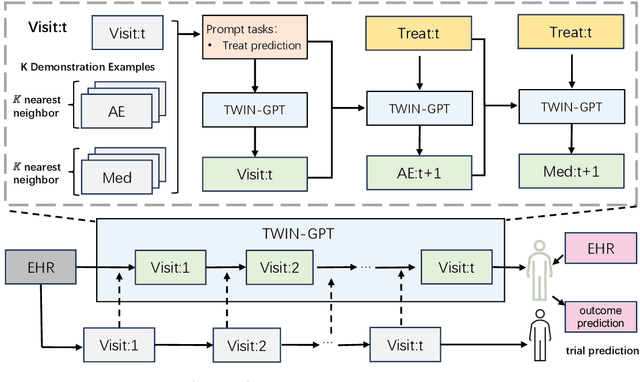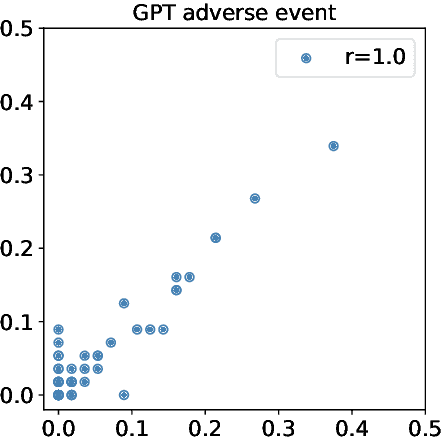Zihan Ma
DiFaR: Enhancing Multimodal Misinformation Detection with Diverse, Factual, and Relevant Rationales
Aug 14, 2025Abstract:Generating textual rationales from large vision-language models (LVLMs) to support trainable multimodal misinformation detectors has emerged as a promising paradigm. However, its effectiveness is fundamentally limited by three core challenges: (i) insufficient diversity in generated rationales, (ii) factual inaccuracies due to hallucinations, and (iii) irrelevant or conflicting content that introduces noise. We introduce DiFaR, a detector-agnostic framework that produces diverse, factual, and relevant rationales to enhance misinformation detection. DiFaR employs five chain-of-thought prompts to elicit varied reasoning traces from LVLMs and incorporates a lightweight post-hoc filtering module to select rationale sentences based on sentence-level factuality and relevance scores. Extensive experiments on four popular benchmarks demonstrate that DiFaR outperforms four baseline categories by up to 5.9% and boosts existing detectors by as much as 8.7%. Both automatic metrics and human evaluations confirm that DiFaR significantly improves rationale quality across all three dimensions.
TrajEvo: Trajectory Prediction Heuristics Design via LLM-driven Evolution
Aug 07, 2025Abstract:Trajectory prediction is a critical task in modeling human behavior, especially in safety-critical domains such as social robotics and autonomous vehicle navigation. Traditional heuristics based on handcrafted rules often lack accuracy and generalizability. Although deep learning approaches offer improved performance, they typically suffer from high computational cost, limited explainability, and, importantly, poor generalization to out-of-distribution (OOD) scenarios. In this paper, we introduce TrajEvo, a framework that leverages Large Language Models (LLMs) to automatically design trajectory prediction heuristics. TrajEvo employs an evolutionary algorithm to generate and refine prediction heuristics from past trajectory data. We propose two key innovations: Cross-Generation Elite Sampling to encourage population diversity, and a Statistics Feedback Loop that enables the LLM to analyze and improve alternative predictions. Our evaluations demonstrate that TrajEvo outperforms existing heuristic methods across multiple real-world datasets, and notably surpasses both heuristic and deep learning methods in generalizing to an unseen OOD real-world dataset. TrajEvo marks a promising step toward the automated design of fast, explainable, and generalizable trajectory prediction heuristics. We release our source code to facilitate future research at https://github.com/ai4co/trajevo.
Rethinking Verification for LLM Code Generation: From Generation to Testing
Jul 09, 2025Abstract:Large language models (LLMs) have recently achieved notable success in code-generation benchmarks such as HumanEval and LiveCodeBench. However, a detailed examination reveals that these evaluation suites often comprise only a limited number of homogeneous test cases, resulting in subtle faults going undetected. This not only artificially inflates measured performance but also compromises accurate reward estimation in reinforcement learning frameworks utilizing verifiable rewards (RLVR). To address these critical shortcomings, we systematically investigate the test-case generation (TCG) task by proposing multi-dimensional metrics designed to rigorously quantify test-suite thoroughness. Furthermore, we introduce a human-LLM collaborative method (SAGA), leveraging human programming expertise with LLM reasoning capability, aimed at significantly enhancing both the coverage and the quality of generated test cases. In addition, we develop a TCGBench to facilitate the study of the TCG task. Experiments show that SAGA achieves a detection rate of 90.62% and a verifier accuracy of 32.58% on TCGBench. The Verifier Accuracy (Verifier Acc) of the code generation evaluation benchmark synthesized by SAGA is 10.78% higher than that of LiveCodeBench-v6. These results demonstrate the effectiveness of our proposed method. We hope this work contributes to building a scalable foundation for reliable LLM code evaluation, further advancing RLVR in code generation, and paving the way for automated adversarial test synthesis and adaptive benchmark integration.
Coding Triangle: How Does Large Language Model Understand Code?
Jul 08, 2025Abstract:Large language models (LLMs) have achieved remarkable progress in code generation, yet their true programming competence remains underexplored. We introduce the Code Triangle framework, which systematically evaluates LLMs across three fundamental dimensions: editorial analysis, code implementation, and test case generation. Through extensive experiments on competitive programming benchmarks, we reveal that while LLMs can form a self-consistent system across these dimensions, their solutions often lack the diversity and robustness of human programmers. We identify a significant distribution shift between model cognition and human expertise, with model errors tending to cluster due to training data biases and limited reasoning transfer. Our study demonstrates that incorporating human-generated editorials, solutions, and diverse test cases, as well as leveraging model mixtures, can substantially enhance both the performance and robustness of LLMs. Furthermore, we reveal both the consistency and inconsistency in the cognition of LLMs that may facilitate self-reflection and self-improvement, providing a potential direction for developing more powerful coding models.
Deciphering Trajectory-Aided LLM Reasoning: An Optimization Perspective
May 26, 2025Abstract:We propose a novel framework for comprehending the reasoning capabilities of large language models (LLMs) through the perspective of meta-learning. By conceptualizing reasoning trajectories as pseudo-gradient descent updates to the LLM's parameters, we identify parallels between LLM reasoning and various meta-learning paradigms. We formalize the training process for reasoning tasks as a meta-learning setup, with each question treated as an individual task, and reasoning trajectories serving as the inner loop optimization for adapting model parameters. Once trained on a diverse set of questions, the LLM develops fundamental reasoning capabilities that can generalize to previously unseen questions. Extensive empirical evaluations substantiate the strong connection between LLM reasoning and meta-learning, exploring several issues of significant interest from a meta-learning standpoint. Our work not only enhances the understanding of LLM reasoning but also provides practical insights for improving these models through established meta-learning techniques.
TrajEvo: Designing Trajectory Prediction Heuristics via LLM-driven Evolution
May 07, 2025



Abstract:Trajectory prediction is a crucial task in modeling human behavior, especially in fields as social robotics and autonomous vehicle navigation. Traditional heuristics based on handcrafted rules often lack accuracy, while recently proposed deep learning approaches suffer from computational cost, lack of explainability, and generalization issues that limit their practical adoption. In this paper, we introduce TrajEvo, a framework that leverages Large Language Models (LLMs) to automatically design trajectory prediction heuristics. TrajEvo employs an evolutionary algorithm to generate and refine prediction heuristics from past trajectory data. We introduce a Cross-Generation Elite Sampling to promote population diversity and a Statistics Feedback Loop allowing the LLM to analyze alternative predictions. Our evaluations show TrajEvo outperforms previous heuristic methods on the ETH-UCY datasets, and remarkably outperforms both heuristics and deep learning methods when generalizing to the unseen SDD dataset. TrajEvo represents a first step toward automated design of fast, explainable, and generalizable trajectory prediction heuristics. We make our source code publicly available to foster future research at https://github.com/ai4co/trajevo.
Each Fake News is Fake in its Own Way: An Attribution Multi-Granularity Benchmark for Multimodal Fake News Detection
Dec 19, 2024



Abstract:Social platforms, while facilitating access to information, have also become saturated with a plethora of fake news, resulting in negative consequences. Automatic multimodal fake news detection is a worthwhile pursuit. Existing multimodal fake news datasets only provide binary labels of real or fake. However, real news is alike, while each fake news is fake in its own way. These datasets fail to reflect the mixed nature of various types of multimodal fake news. To bridge the gap, we construct an attributing multi-granularity multimodal fake news detection dataset \amg, revealing the inherent fake pattern. Furthermore, we propose a multi-granularity clue alignment model \our to achieve multimodal fake news detection and attribution. Experimental results demonstrate that \amg is a challenging dataset, and its attribution setting opens up new avenues for future research.
TWIN-GPT: Digital Twins for Clinical Trials via Large Language Model
Apr 01, 2024



Abstract:Recently, there has been a burgeoning interest in virtual clinical trials, which simulate real-world scenarios and hold the potential to significantly enhance patient safety, expedite development, reduce costs, and contribute to the broader scientific knowledge in healthcare. Existing research often focuses on leveraging electronic health records (EHRs) to support clinical trial outcome prediction. Yet, trained with limited clinical trial outcome data, existing approaches frequently struggle to perform accurate predictions. Some research has attempted to generate EHRs to augment model development but has fallen short in personalizing the generation for individual patient profiles. Recently, the emergence of large language models has illuminated new possibilities, as their embedded comprehensive clinical knowledge has proven beneficial in addressing medical issues. In this paper, we propose a large language model-based digital twin creation approach, called TWIN-GPT. TWIN-GPT can establish cross-dataset associations of medical information given limited data, generating unique personalized digital twins for different patients, thereby preserving individual patient characteristics. Comprehensive experiments show that using digital twins created by TWIN-GPT can boost clinical trial outcome prediction, exceeding various previous prediction approaches. Besides, we also demonstrate that TWIN-GPT can generate high-fidelity trial data that closely approximate specific patients, aiding in more accurate result predictions in data-scarce situations. Moreover, our study provides practical evidence for the application of digital twins in healthcare, highlighting its potential significance.
HiMAP: Learning Heuristics-Informed Policies for Large-Scale Multi-Agent Pathfinding
Feb 23, 2024
Abstract:Large-scale multi-agent pathfinding (MAPF) presents significant challenges in several areas. As systems grow in complexity with a multitude of autonomous agents operating simultaneously, efficient and collision-free coordination becomes paramount. Traditional algorithms often fall short in scalability, especially in intricate scenarios. Reinforcement Learning (RL) has shown potential to address the intricacies of MAPF; however, it has also been shown to struggle with scalability, demanding intricate implementation, lengthy training, and often exhibiting unstable convergence, limiting its practical application. In this paper, we introduce Heuristics-Informed Multi-Agent Pathfinding (HiMAP), a novel scalable approach that employs imitation learning with heuristic guidance in a decentralized manner. We train on small-scale instances using a heuristic policy as a teacher that maps each single agent observation information to an action probability distribution. During pathfinding, we adopt several inference techniques to improve performance. With a simple training scheme and implementation, HiMAP demonstrates competitive results in terms of success rate and scalability in the field of imitation-learning-only MAPF, showing the potential of imitation-learning-only MAPF equipped with inference techniques.
Unsupervised semantic segmentation of high-resolution UAV imagery for road scene parsing
Feb 05, 2024



Abstract:Two challenges are presented when parsing road scenes in UAV images. First, the high resolution of UAV images makes processing difficult. Second, supervised deep learning methods require a large amount of manual annotations to train robust and accurate models. In this paper, an unsupervised road parsing framework that leverages recent advances in vision language models and fundamental computer vision model is introduced.Initially, a vision language model is employed to efficiently process ultra-large resolution UAV images to quickly detect road regions of interest in the images. Subsequently, the vision foundation model SAM is utilized to generate masks for the road regions without category information. Following that, a self-supervised representation learning network extracts feature representations from all masked regions. Finally, an unsupervised clustering algorithm is applied to cluster these feature representations and assign IDs to each cluster. The masked regions are combined with the corresponding IDs to generate initial pseudo-labels, which initiate an iterative self-training process for regular semantic segmentation. The proposed method achieves an impressive 89.96% mIoU on the development dataset without relying on any manual annotation. Particularly noteworthy is the extraordinary flexibility of the proposed method, which even goes beyond the limitations of human-defined categories and is able to acquire knowledge of new categories from the dataset itself.
 Add to Chrome
Add to Chrome Add to Firefox
Add to Firefox Add to Edge
Add to Edge